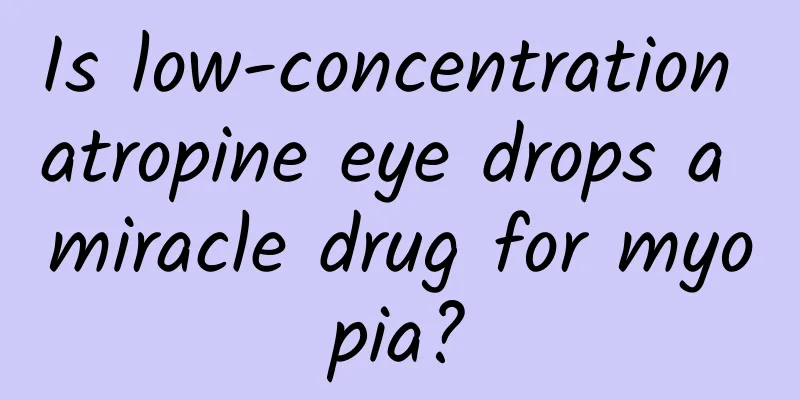Is low-concentration atropine eye drops a miracle drug for myopia?

|
Low concentration atropine eye drops are 0.01% atropine eye drops, which can effectively delay the development of myopia. According to the results of a large-scale clinical study in Singapore, children aged 6 to 12 were given atropine eye drops of different concentrations (0.5%, 0.1% and 0.01%) for 2 years, and it was found that the higher the concentration of atropine eye drops, the better the effect of controlling myopia. However, these children stopped taking the medicine for 1 year, and it was found that the children who used atropine eye drops with a higher concentration had a faster rebound of myopia. Children whose myopia progressed rapidly after stopping the medicine continued to use 0.01% atropine eye drops for 2 years. The results showed that the 0.01% atropine group could effectively slow the rate of myopia progression for 5 years, with minimal side effects and the smallest rebound effect of myopia after stopping the medicine. In China, some hospitals have developed in-hospital preparations of 0.01% atropine eye drops, which have been approved for in-hospital use by provincial drug regulatory authorities. Low-concentration atropine eye drops have become the third magic weapon for myopia prevention and control in addition to outdoor activities and orthokeratology lenses (OK lenses), and are more convenient to use than the other two magic weapons. It was once popular on the Internet, and many parents believed that it could prevent or even treat myopia in children. It was called the "myopia magic drug" on the Internet. Many parents with myopic children have tried hard to find out where they can buy this "magic drug". We believe in the results of clinical research, but we should not deify atropine. Today, let us get to know this star in the myopia world. Can I use 0.01% atropine eye drops directly if myopia is diagnosed? The first thing is to monitor the progression of myopia. At present, 0.01% atropine eye drops are generally used to prevent and control myopia in adolescent patients with rapid myopia progression. The increase in myopia is mainly related to the excessive use of children's eyes at close range. Some children can control myopia by wearing frame glasses, reducing close-range eye use, increasing outdoor activities, paying attention to eye posture, etc., so there is no need to use eye drops. If these methods of preventing and controlling myopia do not work, and the binocular vision function is normal, you can try using 0.01% atropine eye drops. Although the concentration of atropine eye drops is very low, it is a ciliary muscle paralysis drug after all. Even if some children use it at night, they still feel difficulty in seeing close objects and photophobia during the day. Therefore, before using low-concentration atropine eye drops, go to a regular hospital to check the binocular vision function of the child. In addition, although the effect of low-concentration atropine eye drops in controlling the progression of myopia has been confirmed by clinical trials, it is not effective for everyone and there is a certain non-response rate. Some children have very good results after using it. They may use it for two or three years without any increase in their eyesight. However, for some children, after using it, their eyesight may develop too fast, and low-concentration atropine eye drops are not enough to control the increase in their eyesight. In other words, some children do not see any effect even after using it! Therefore, do not blindly use low-concentration atropine eye drops on your own. Instead, use them only when a doctor assesses the need. Low-concentration atropine eye drops can only slow down the progression of myopia, and you still need to wear glasses during the day. In what cases can 0.01% atropine eye drops be used Atropine has two main functions. One is to effectively slow down the growth of the eye axis. Due to the growth of the eye axis, the light spot formed by the refractive system is projected in front of the retina, which is called myopia, so delaying the growth of the eye axis is a very important part of preventing and controlling myopia. Atropine can increase the thickness of the choroid and inhibit the growth of the eye axis. The second is to relax the eye muscles. Atropine eye drops can block the control of the ciliary muscle and pupillary sphincter by the cholinergic nerve, effectively relieve eye muscle spasms and fatigue, and thus achieve the effect of controlling the development of myopia. If the child belongs to one of the following three situations: the degree of myopia progresses by more than 50 degrees each year, there is a tendency of high myopia, and there is an urgent need to control myopia but cannot tolerate orthokeratology lenses (OK lenses), rigid corneal contact lenses (RGP) and other treatments, you can use 0.01% atropine eye drops under the guidance of a pharmacist after examination by a professional physician in a regular medical institution. How to use 0.01% atropine eye drops and how long to use it Every night before going to bed, put one drop in each eye, close your eyes, and press the inner corner of your eye for at least 2 minutes to avoid absorption by the nasal mucosa and reduce possible side effects. According to research, it is recommended that 0.01% atropine eye drops be used continuously for 2 years. If the condition worsens, it can be used for 5 years. Generally, when children are over 14 years old, their myopia will not increase, so we can stop taking the medicine. How long should I check after taking the medicine? It is recommended to have a follow-up examination every three months to check the increase in the degree of myopia, intraocular pressure and the growth of the eye axis. The growth of the eye axis can be used to evaluate whether the use of 0.01% atropine eye drops has effectively controlled the progression of myopia. In addition, the child's tolerance can be judged by intraocular pressure. If the child's intraocular pressure is high, it means that he may not be very tolerant of this eye drops, and it may be necessary to stop the medication. An assessment must be done every year. Myopia control is considered effective if the progression is 50 degrees or less in one year. If the progression exceeds 75 degrees in one year, other intervention methods or combined interventions can be considered. What are the side effects of this eye drops? 0.01% atropine eye drops are a relatively mild mydriatic drug. Although it has few side effects, it still causes the pupil to dilate slightly. Therefore, children who use 0.01% atropine eye drops will see slightly blurred near objects, a bit like the symptoms of presbyopia. A few children still have slightly dilated pupils after getting up the next day, which slightly affects their vision when reading. If a child uses this eye drop and does some exercise on a sunny morning, he will feel a little afraid of the light. A small number of children will also experience drug allergies. The safety and side effects of using low-concentration atropine to control myopia are still controversial. It should be made clear that atropine should never be used as a routine medication for daily myopia prevention and control! It should not be used as a preventive medication for children who have not yet developed myopia! What are the precautions for using 0.01% atropine eye drops? It should not be used by adolescents with glaucoma or those who are prone to glaucoma, and it should not be used by those who are allergic to the atropine component. After using low-concentration atropine, if side effects such as photophobia and blurred near vision occur, sunglasses or nearsighted glasses can be used to relieve the discomfort; if atropine is not effective in controlling myopia, the myopia control plan needs to be adjusted under the guidance of a professional doctor. 0.01% atropine eye drops can be used by myopic patients from 4 years old to adolescence, but if children under 6 years old need to use this drug, they need to be more closely monitored and followed up. Low-concentration atropine must be purchased with a prescription after visiting a regular offline hospital In October 2021, the National Health Commission issued the "Appropriate Technical Guidelines for the Prevention and Control of Myopia in Children and Adolescents (Updated Version)", which pointed out that if children or adolescents suffer from myopia and need to use 0.01% atropine eye drops or wear orthokeratology lenses (OK lenses) to delay the development of myopia, it is recommended to go to a regular medical institution, obtain a prescription after examination by a professional doctor, and use it according to the doctor's orders. Recently, low-concentration atropine eye drops have been suspended from online sales and need to be purchased with a prescription after visiting a regular offline hospital. As a clinical pharmacist, I think this is conducive to standardizing the use of atropine eye drops, which is equivalent to strengthening the doctor's gatekeeper role. If you plan to use 0.01% atropine eye drops, you must first go to a professional medical institution to see an ophthalmologist, let the doctor conduct relevant examinations, understand the condition, and then prescribe and give professional advice. Doctors or pharmacists will also inform parents of the effectiveness and risks of such drugs to avoid blind use of low-concentration atropine; when purchasing again, they will also need to be reviewed and evaluated by a doctor and a prescription will be issued, which will help monitor the effectiveness of the medication and conduct follow-up observations, making the diagnosis and treatment process for myopia in adolescents more standardized and more in line with the requirements of full disease management. Myopia is irreversible and cannot be treated with certain eye drops, so preventing myopia is the key. 1. Don’t rely solely on eye drops to control myopia. The most important thing is to develop and maintain good eye habits. 2. Ensure sufficient light when reading and writing. Insufficient light will make the eyes more tired, increase the probability of myopia, and make myopia worse, so ensure sufficient light. 3. Do eye exercises regularly. If you use your eyes for more than 2 hours, you can spend about 10 minutes doing eye exercises to relax the eye nerves and the pressure around the eyes, which is very helpful for protecting your eyesight. 4. Ensure adequate sleep and eye use time. The best way to prevent myopia is to go to bed early and ensure 8 hours of sleep every night; do not look at your phone, read books or use the computer for a long time before going to bed. When looking at your phone, TV or computer, take a 15-minute break after watching for 1 hour, and do not use your eyes in strong sunlight. 5. Reduce close-up eye use, pay attention to eye posture, and increase outdoor activities. 6. Pay attention to rest more, take more vitamins, maintain a balanced diet, drink more chrysanthemum tea, eat more fruits and vegetables, reduce the use of electronic products, and correct your reading posture. If you feel any discomfort in your eyes, please go to the hospital for examination in time. |
<<: For the treatment of hypertension, just read this article!
>>: Interpret the blood sugar index you care about most
Recommend
How long does it take to produce milk after a normal birth?
There are two ways for women to give birth, one i...
Menstruation comes 10 days early with less and darker color
Women's menstrual periods are usually very re...
This way you clean your pores and leave no room for dirt to escape!
Loving beauty is a woman’s nature. Many women hav...
What are the symptoms of atrophic vaginitis?
Atrophic vaginitis threatens the health of women....
Causes of small red bumps on the vulva
For women, reproductive health is the first healt...
【Weight Management】"Three Dietary Reductions and Three Healthy Bodies" A healthy and beautiful life begins every day
This month is the National Healthy Lifestyle Prom...
If you have a bad stomach, eat more of these stomach-nourishing foods!
Everything we eat every day passes through our st...
What is the normal oral temperature of a pregnant woman?
From the beginning of pregnancy, pregnant women h...
Causes of Second-Degree Cervicitis
Women are still quite afraid of getting gynecolog...
When is the best time to do a vaginal examination?
In recent years, with the increasing incidence of...
Menstrual irregularities after IUD insertion
Menstruation is a normal phenomenon in the female...
Burning sensation in the vagina after urinating
The female genitals often secrete substances simi...
How to make chicken soup the most nutritious? How long to stew chicken soup
Chicken soup is a traditional soup dish and a com...
How to control the abdomen during confinement
Many women experience significant physical change...









